The Ischemic Hepatitis Treatment Market is estimated to be valued at USD 7.4 billion in 2025 and is projected to reach USD 12.7 billion by 2035, registering a compound annual growth rate (CAGR) of 5.5% over the forecast period.
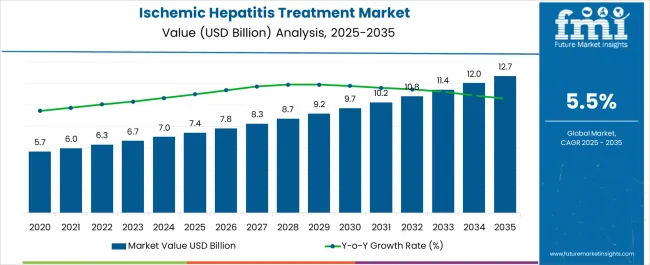
| Metric | Value |
|---|---|
| Ischemic Hepatitis Treatment Market Estimated Value in (2025 E) | USD 7.4 billion |
| Ischemic Hepatitis Treatment Market Forecast Value in (2035 F) | USD 12.7 billion |
| Forecast CAGR (2025 to 2035) | 5.5% |
The Ischemic Hepatitis Treatment market is experiencing steady expansion due to the rising prevalence of liver injuries caused by circulatory disorders and systemic infections. The current market environment is being influenced by an increasing number of hospital admissions related to cardiac complications, septic shock, and hepatic ischemia. Growing awareness among healthcare providers regarding early diagnosis and intervention has supported the adoption of effective treatment protocols.
The future outlook for this market is expected to be strengthened by advancements in pharmacological therapies that address liver inflammation, oxidative stress, and tissue damage. The increasing integration of multi-disciplinary treatment approaches in critical care units is being seen as a key factor driving demand. Furthermore, hospitals and healthcare networks are prioritizing early-stage intervention and supportive treatment strategies to reduce mortality and improve patient outcomes.
Investments in clinical trials, along with the development of novel formulations and drug delivery systems, are also providing pathways for innovation As healthcare systems globally work toward improving patient care in intensive settings, the Ischemic Hepatitis Treatment market is projected to maintain a positive growth trajectory.
The ischemic hepatitis treatment market is segmented by treatment type, application, distribution channel, and geographic regions. By treatment type, ischemic hepatitis treatment market is divided into Acetylcysteine-Based Ischemic Hepatitis Treatment, Antibiotics-Based Ischemic Hepatitis Treatment, Ischemic Hepatitis Supportive Care, and Liver Transplant-Based Ischemic Hepatitis Surgery. In terms of application, ischemic hepatitis treatment market is classified into Ischemic Hepatitis Treatment For Infection Control, Ischemic Hepatitis Treatment For Tissue Perfusion, Ischemic Hepatitis Treatment For Mechanical Ventilation, and Ischemic Hepatitis Treatment For Metabolic Monitoring.
Based on distribution channel, ischemic hepatitis treatment market is segmented into Ischemic Hepatitis Treatment Drug Sales Via Hospital Pharmacies, Ischemic Hepatitis Treatment Drug Sales Via Retail Pharmacies, and Ischemic Hepatitis Treatment Drug Sales Via Online Pharmacies. Regionally, the ischemic hepatitis treatment industry is classified into North America, Latin America, Western Europe, Eastern Europe, Balkan & Baltic Countries, Russia & Belarus, Central Asia, East Asia, South Asia & Pacific, and the Middle East & Africa.
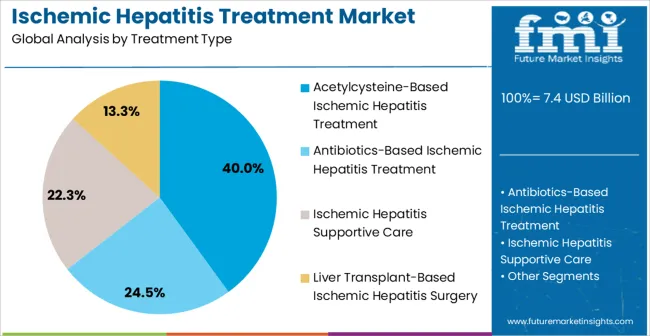
The Acetylcysteine-Based Ischemic Hepatitis Treatment segment is expected to account for 40.0% of the overall treatment type revenue share in 2025, making it the largest segment within the market. This dominance is being attributed to the therapeutic benefits offered by acetylcysteine in reducing oxidative stress and improving liver function in patients suffering from ischemic injuries. The treatment’s ability to replenish glutathione levels and support hepatic detoxification has resulted in increased trust among physicians and healthcare providers in intensive care settings.
Moreover, acetylcysteine formulations are being favored due to their wide availability and well-understood safety profile. Adoption has been further supported by clinical protocols that recommend early administration to prevent progression of liver failure.
As healthcare practitioners continue to prioritize treatments that offer measurable improvements in patient recovery and prognosis, acetylcysteine-based therapies are being widely integrated into standard care pathways The segment’s growth is expected to continue as research and supportive therapies expand its application across a broader patient base.
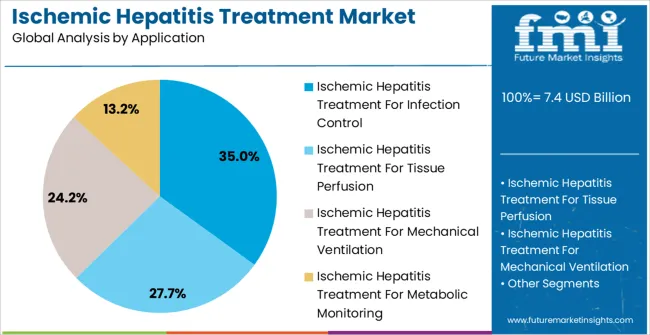
The Ischemic Hepatitis Treatment for Infection Control segment is projected to hold 35.0% of the total application revenue share in 2025, marking it as the leading application within the market. This position is being driven by the increasing need to manage infection-related liver complications in critically ill patients. Infections, particularly sepsis and systemic inflammatory responses, are recognized as common triggers of hepatic ischemia, thereby reinforcing the importance of integrated treatment approaches.
The treatment protocols in this segment have been supported by clinical guidelines recommending a combination of antimicrobial therapy, supportive liver care, and early-stage monitoring to control infection while minimizing hepatic injury. Healthcare facilities are adopting these treatment models as a means of reducing hospital stays and improving survival rates.
The segment’s expansion is also being influenced by rising investment in infection prevention programs, along with a growing emphasis on patient safety and personalized care in intensive care units With infections remaining a major driver of hepatic complications, the segment is anticipated to see sustained growth in treatment adoption.
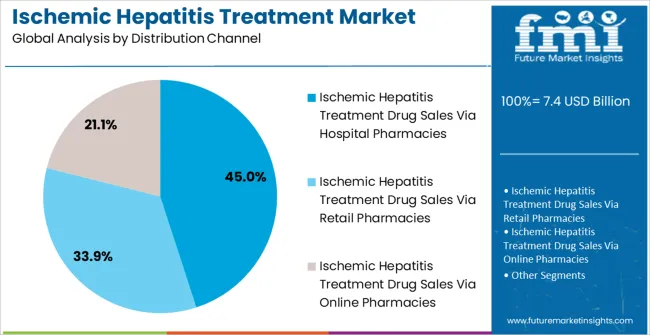
The Ischemic Hepatitis Treatment Drug Sales Via Hospital Pharmacies segment is forecasted to represent 45.0% of the overall distribution channel revenue share in 2025, making it the largest channel in the market. This growth is being supported by hospitals’ increased focus on providing specialized care in controlled environments where advanced therapies are readily accessible.
Hospital pharmacies are considered critical in ensuring that patients with ischemic hepatitis receive timely access to prescription therapies that require strict dosing, monitoring, and clinical oversight. The adoption of hospital pharmacy channels has been further accelerated by the preference for integrated treatment protocols that combine supportive care with liver-targeted medications.
Additionally, government initiatives aimed at improving healthcare infrastructure and patient management in tertiary and quaternary care centers are contributing to the expansion of this distribution channel As hospitals continue to play a central role in managing critical care cases, the accessibility of treatment through hospital pharmacies is expected to remain a key growth driver, particularly in regions where advanced care units are being expanded and supported by ongoing healthcare investments.
Ischemic hepatitis, also known as shock liver, affects 0.18 percent to 0.50 percent of inpatient admissions each year. Typically, the affected patient has no symptoms of abdominal pain, and the diagnosis is based on biochemical blood analysis. In ischemic hepatitis, there is a significant and noticeable increase in enzymes within the liver; the level will rise more than seven to nine times to normal. Within 8-11 days, the enzyme level will return to normal as disease-causing agents such as viruses or hepatotoxic agents are eliminated from the body.
Additionally, the serum lactate level may rise. Ischemic hepatitis can also develop following episodes of cardiac failure, hemodynamic instability, or hypoxia, such as pulmonary embolus, hemorrhage, sepsis, acute myocardial infarction, or other causes of respiratory distress.
Although there is no specific treatment for ischemic hepatitis, the symptoms of ischemic hepatitis can be alleviated with the use of ischemic hepatitis treatment drugs. The current progress in Ischemic Hepatitis Treatment drugs in re-establishing blood flow to the liver is expected to increase physician adoption of Ischemic Hepatitis Treatment.
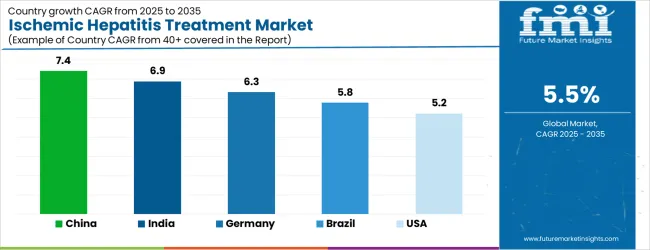
| Country | CAGR |
|---|---|
| China | 7.4% |
| India | 6.9% |
| Germany | 6.3% |
| Brazil | 5.8% |
| USA | 5.2% |
| UK | 4.7% |
| Japan | 4.1% |
The Ischemic Hepatitis Treatment Market is expected to register a CAGR of 5.5% during the forecast period, exhibiting varied country level momentum. China leads with the highest CAGR of 7.4%, followed by India at 6.9%. Developed markets such as Germany, France, and the UK continue to expand steadily, while the USA is likely to grow at consistent rates. Japan posts the lowest CAGR at 4.1%, yet still underscores a broadly positive trajectory for the global Ischemic Hepatitis Treatment Market. In 2024, Germany held a dominant revenue in the Western Europe market and is expected to grow with a CAGR of 6.3%. The USA Ischemic Hepatitis Treatment Market is estimated to be valued at USD 2.8 billion in 2025 and is anticipated to reach a valuation of USD 2.8 billion by 2035. Sales are projected to rise at a CAGR of 0.0% over the forecast period between 2025 and 2035. While Japan and South Korea markets are estimated to be valued at USD 387.1 million and USD 222.6 million respectively in 2025.
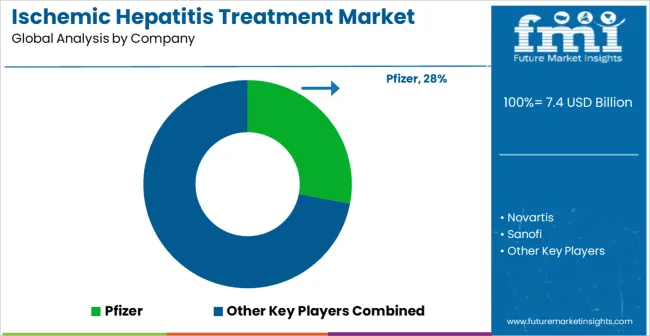
| Item | Value |
|---|---|
| Quantitative Units | USD 7.4 Billion |
| Treatment Type | Acetylcysteine-Based Ischemic Hepatitis Treatment, Antibiotics-Based Ischemic Hepatitis Treatment, Ischemic Hepatitis Supportive Care, and Liver Transplant-Based Ischemic Hepatitis Surgery |
| Application | Ischemic Hepatitis Treatment For Infection Control, Ischemic Hepatitis Treatment For Tissue Perfusion, Ischemic Hepatitis Treatment For Mechanical Ventilation, and Ischemic Hepatitis Treatment For Metabolic Monitoring |
| Distribution Channel | Ischemic Hepatitis Treatment Drug Sales Via Hospital Pharmacies, Ischemic Hepatitis Treatment Drug Sales Via Retail Pharmacies, and Ischemic Hepatitis Treatment Drug Sales Via Online Pharmacies |
| Regions Covered | North America, Europe, Asia-Pacific, Latin America, Middle East & Africa |
| Country Covered | United States, Canada, Germany, France, United Kingdom, China, Japan, India, Brazil, South Africa |
| Key Companies Profiled | Pfizer, Novartis, Sanofi, GlaxoSmithKline, AstraZeneca, Bristol-Myers Squibb, Allergen, and Merck |
The global ischemic hepatitis treatment market is estimated to be valued at USD 7.4 billion in 2025.
The market size for the ischemic hepatitis treatment market is projected to reach USD 12.7 billion by 2035.
The ischemic hepatitis treatment market is expected to grow at a 5.5% CAGR between 2025 and 2035.
The key product types in ischemic hepatitis treatment market are acetylcysteine-based ischemic hepatitis treatment, antibiotics-based ischemic hepatitis treatment, ischemic hepatitis supportive care and liver transplant-based ischemic hepatitis surgery.
In terms of application, ischemic hepatitis treatment for infection control segment to command 35.0% share in the ischemic hepatitis treatment market in 2025.
Explore Similar Insights

Thank you!
You will receive an email from our Business Development Manager. Please be sure to check your SPAM/JUNK folder too.
Chat With
MaRIA